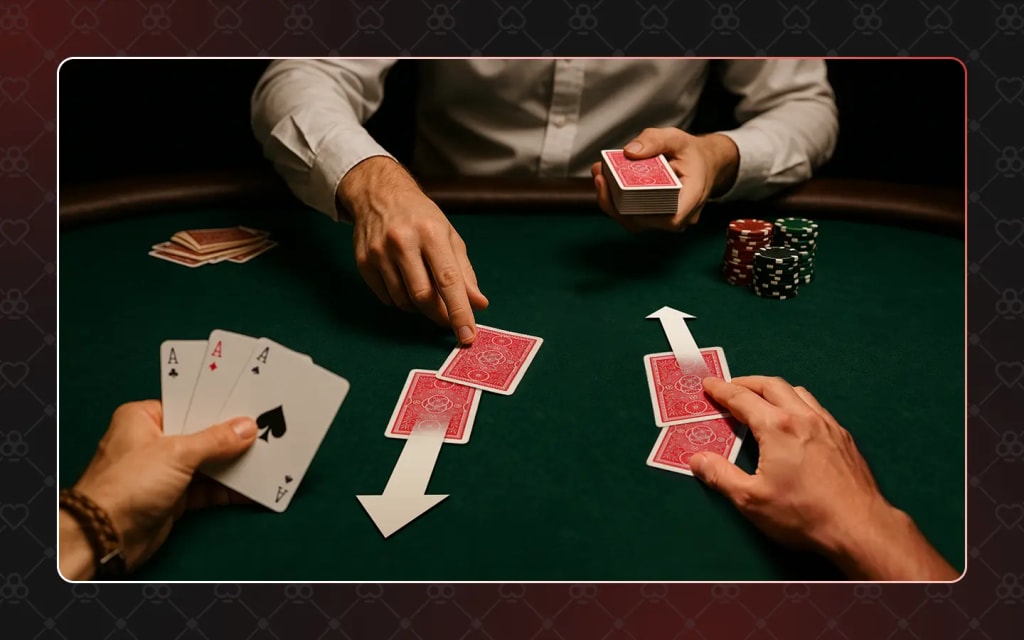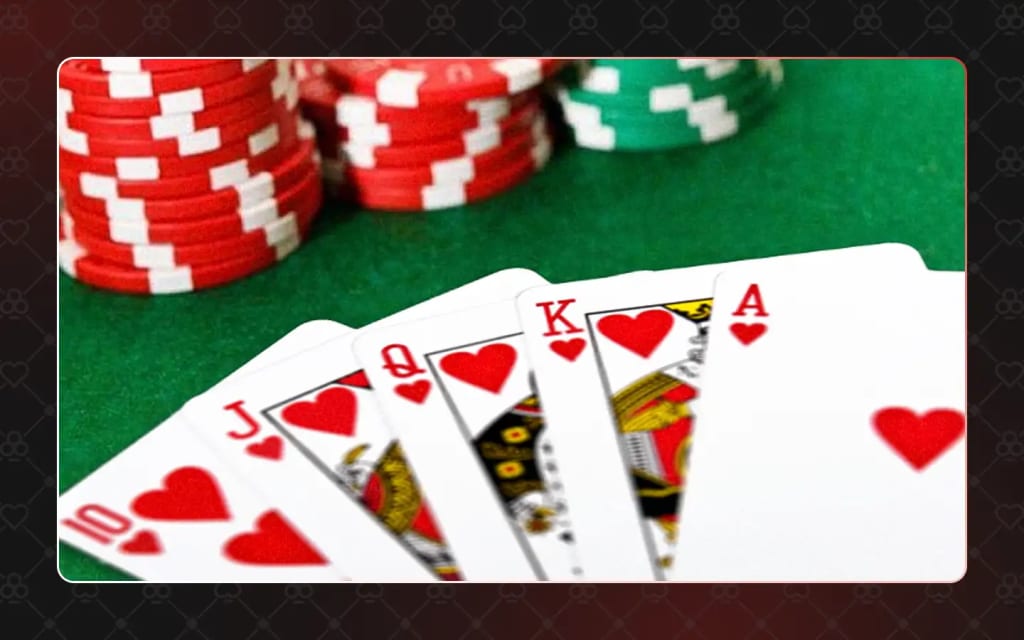5 Card Draw: The Art, History, and Strategy of Poker’s Classic Game

Before Texas Hold’em became the most popular form of poker, flooding casinos and televised games, 5 Card Draw was the favorite game of saloon gamblers, Wild West cowboys, and casual players. With its simple structure but great strategic depth, five card poker with draws is poker’s purest form, where calculated risk-taking rewards the patient.
Whether you’re an old-timer or a curious newcomer, Five Card Draw offers a nostalgic experience and strategic battles for everyone.
In our comprehensive guide, we aim to take you through 5 Card Draw’s history, its rules, similarities, and differences with classic Texas Hold’em, and also provide you with basic and more advanced strategies to help you get started.
A Brief History of 5 Card Draw
Long before the World Series of Poker and televised high-stakes Hold’em games took over, 5 Card Draw was hands down the most popular poker variant. The game originates from America, where it evolved from European card games like Poque and Brag in the early 19th century.
5 Card Draw became the favorite pastime in saloons, riverboats, and even Civil War military camps by the mid-1800s. Being the most popular game in the lawless gambling dens of the Wild West, the game has a rich history and deep lore with countless myths and legends surrounding it. Who hasn’t heard of the folk hero Wild Bill Hickock, who was playing 5 Card Draw, holding a pair of Aces and eight (now called the ‘Dead Man’s Hand’), when he was shot?
The game drew back from the mainstream as Texas Hold’em gained popularity thanks to televised tournaments like the WSOP, but from time to time, there is a kind of retro revival of the classic game.
“5 Card Draw is poker stripped down to its essence – no community cards, no distractions. Just you, your hand, and your ability to read the table”
said Doyle Brunson famously. And how can players not return to it when even the Godfather of Poker considers it the essential form of our beloved game?

In our comprehensive guide, we aim to take you through 5 Card Draw’s history, its rules, similarities, and differences with classic Texas Hold’em, and also provide you with basic and more advanced strategies to help you get started.
The Rules of 5 Card Draw
As opposed to Texas Hold’em or Pot Limit Omaha, 5 Card Draw rules are very different. It is a ‘closed’ game, in the sense that players only see their own cards. Because there are no shared community cards, bluffing and hand-reading become even more important than in community card games.
5 Card Draw can be played with 2 to 10 players using a standard 52-card deck. Players have to make the best possible five-card hand by discarding from their hands and drawing new cards from the deck to replace them.
Before dealing any cards, every player has to post a mandatory bet called ‘ante’. The purpose of these blind bets is to make sure there is always some money in the middle to incentivize action from the players.
When the ante is posted, each player is dealt five private cards face down, and the first betting round begins.
Players can either:
- throw their cards away or ‘fold’
- pass the opportunity of action or ‘check’
- put in money or ‘bet’
After all players have acted, they can choose to discard and replace up to five private cards from the deck, or ‘stand pat’ if they want to keep all five of their private cards.
After all players have acted, a second round of betting ensues. After this second betting round concludes, the remaining players reveal their hands, and the best five-card hand wins.
Hands are ranked according to traditional poker hierarchy, from high card to royal flush.
5 Card Draw Hand Rankings
To evaluate their own and their opponents’ hands, players need to be familiar with the hand ranking hierarchy of the game. Here are the rankings for every possible combination, sorted from highest to lowest:
| Hand | Example |
|---|---|
| Royal Flush | A♥ K♥ Q♥ J♥ 10♥ |
| Straight Flush | 9♣ 8♣ 7♣ 6♣ 5♣ |
| Four of a Kind | 7♦ 7♥ 7♠ 7♣ 2♠ |
| Full House | Q♠ Q♥ Q♦ 5♣ 5♥ |
| Flush | A♠ J♠ 8♠ 4♠ 2♠ |
| Straight | 10♦ 9♣ 8♥ 7♠ 6♦ |
| Three of a Kind | K♣ K♦ K♠ 9♥ 2♦ |
| Two Pair | J♥ J♣ 4♦ 4♠ 9♠ |
| One Pair | 10♠ 10♦ Q♣ 7♥ 3♠ |
| High Card | A♦ K♣ Q♥ 9♠ 4♣ |

Basic Strategies & Tips for 5 Card Draw
5 Card Draw is a game of incomplete information: players only see their five private cards, but not their opponents’ cards. Because of the nature of the game, reading opponents, dealing with unknown factors, and managing risk are just as important as the player’s own cards.
Here are some essential strategies to help you get started:
Starting Hand Selection
In the long run, some hands perform much better than others. You should take the time to carefully evaluate the strength of your cards before betting or drawing. It is best to play strong starting hands like high pairs, three-of-a-kind or better, four-card flushes, and straight draws. Let go of weak hands even before the draw in order to avoid costly mistakes on later betting rounds.
Drawing Is Information
Because there are no community cards, the only information your opponents can get about your hand is based on how many cards you choose to draw. If you stand pat or keep all five of your cards, it signals strength, maybe an already made straight or flush. If you draw one card, it often means that you are chasing a straight or a flush, or want to improve a single pair. If you draw three or more cards, it suggests that you have a weak hand. Be careful, because all these can be deceptive bluffs as well!
Play Aggressively
5 Card Draw rewards those who are not afraid to play aggressively. You should bet and raise often to put a lot of pressure on your opponents. Bet your strong hands hard to build the pot.
Apply Semi-Bluffs
Drawing just one single card can signal to your opponents that you have a strong hand. Try drawing just one card, even when your hand still needs to improve, to throw your opponents off!
Spot Your Opponents’ Weakness
If one of your opponents draws multiple cards, it most likely means that they only have a weak holding. If you apply pressure to them, they might easily fold.
Advanced Tips & Tricks for 5 Card Draw
Adjust Your Strategy Based On Position
Deviate from your basic strategy depending on your position. Late positions give you an advantage because you act last after the draw, and can gather more information before the betting round begins. Play more hands from late positions to take this advantage. Conversely, you should play fewer hands from early positions, because you have less information, and you will act first in future rounds.
Profile Your Opponents
Pay careful attention to your opponents’ actions, and put them into player categories. Calling stations call too often, so you should value bet them a lot. Nits fold under pressure, so you can easily bluff them off marginal hands. Maniacs overbet their weak hands, so you can trap them with your strong holdings.
Balance Your Range
If you only bet your strong holdings, players might quickly find out about your strategy. You should avoid being predictable by mixing strong hands as well as bluffs in your betting patterns. This will make it more difficult for your opponents to exploit your strategy.
Give False Tells
You can misdirect your opponents by acting weak with your strong hands or acting strong with your weak hands.
Common Mistakes to Avoid in 5-Card Draw
Overvaluing Weak Pairs
With all the drawing going on, you are not very likely to win with a low pair on the showdown, so keeping a low pair, like a pair of sixes, and drawing three is not the best strategy. You should fold weak pairs unless you are in late position, playing against passive opponents.
Ignoring Betting Patterns
If you do not pay attention to your opponents, you will most probably miss out on valuable information. Take at least mental notes on how your opponents bet after the draw, so you can adjust your strategy to their tendencies.

Drawing Too Many Cards
If you always discard three, four, or even five cards, you basically hope that a miracle happens. Be selective with your actions; sometimes it is better to just fold than to chase a miracle improvement of your card combinations.
Underbluffing
If you never bluff, your play will be absolutely predictable, and smart opponents might exploit your weakness. You should bluff strategically, especially against tight players, who play few hands.
5 Card Draw vs. Texas Hold’em
Generally speaking, 5 Card Draw requires more psychological reads, while Texas Hold’em demands deeper mathematical knowledge.
To help you memorize the differences between 5 Card Draw and Texas Hold’em, here is a comparison table:
| Feature | 5-Card Draw | Texas Hold’em |
|---|---|---|
| Cards Visible | Only your hand | Shared community cards |
| Bluffing | More psychological | More mathematical |
| Complexity | Simpler rules | More variables |
| Skill Emphasis | Reading opponents | Calculating odds |
| Popularity | Niche, retro appeal | Mainstream, tournament standard |
How to Get Started with 5 Card Draw
Want to start playing 5 Card Draw, but don’t know where to start? Here are some tips to help you get ahead of the competition:
Learn the Basic Rules
Many players aren’t even familiar with the rules of the game, so knowing exactly how the game is played can already give you an edge over them.
Take The Time to Study
Being disciplined about regular study sessions is what separates great players from mediocre ones. There are many free and paid courses on 5 Card Draw online for players of every skill level.

Join a Community
Discussing strategies and hands with other 5 Card Draw players can be very valuable when starting out. Join forums like TwoPlusTwo or CardsChat to converse with people who share your interest in the game.
Play Online
Playing online can improve your game fast because hands are played faster than in live poker, and you can also play multiple tables at once. This means that you can gain much more experience playing online than you would if you spent a day in a casino!
What is more, many sites offer low-stakes tables where you can play without risking too much money.
Start with Low-Stakes Games
When you feel that you are ready to play with real money, start playing small stakes. When you have built enough confidence there, you can safely move up to the next stake.
Ready to test your skills? Join an online poker platform like CoinPoker or Natural8 to practice and compete against players worldwide. Remember, every pro was once a beginner.



















